History and evolution of contact centers
Alexander Graham Bell, Steve Jobs and the Baby Bells played notable roles in the contact center's transformation into the front line of communication for businesses and customers.
In relaying the history of contact centers in business, the tendency is to journey back several decades when customer service essentially comprised a department store's service desk for product returns and a telephone for incoming calls. But considering the contact center's history is built on fulfilling orders, keeping records and communications, the concept dates back thousands of years.
Egyptian scribes in 3000 B.C. recorded sales of consumer items and their suppliers to prevent fraud, and the Persians 2,500 years later devised a postal method for delivering and receiving mail. The invention of the telephone by Alexander Graham Bell nearly 150 years ago provided the foundations for the advent of call centers in the 1960s. Over the past few decades, traditional, phone-based call centers have evolved into complex, multifunctional, multichannel contact centers.
Advancements in voice over IP (VoIP), the cloud, outsourcing and AI enabled customers to conveniently communicate with businesses by phone, text messaging, email, web chat, chatbots, social media, mobile apps and video. Now generative AI (GenAI) is in the early stages of transforming the way contact centers interact with customers.
Contact centers have had their share of issues through the years, especially when it comes to outbound calls in the form of telemarketing and robocalls. More recently, cybercriminals have found new ways to scam unsuspecting victims, inducing them to download malware or disclose personal information during calls, texts and web interactions. These developments have prompted new laws and regulations that affect how contact centers operate.
Evolution of contact center technology
The evolution of the contact center was built on innovations to improve record-keeping, efficiency, scalability and automation. The modern contact center can trace its roots to Egyptian scribes tasked with recording customer orders thousands of years ago. Businesses eventually found better ways to handle mail, calls, texts and other forms of communication. Today's significant advancements focus on consolidating multiple contact channels into omnichannel experiences and creating new applications for chatbots and GenAI to cost effectively resolve customer inquiries without requiring human agents.
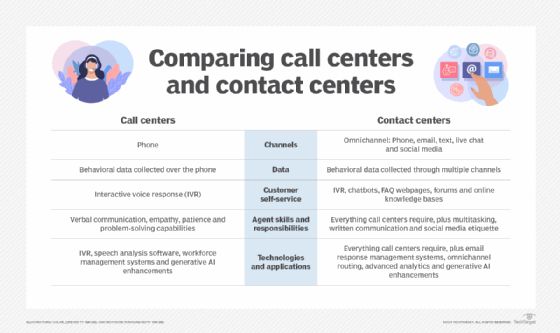
3000 B.C.
Under the reign of King Scorpion I, Egyptian scribes began keeping meticulous records of sales and suppliers to help improve customer engagements and reduce fraud. Contact centers progressed slowly as businesses gradually refined customer-related record-keeping techniques.
550 B.C.
Persian King Cyrus the Great mandated that every province in his kingdom create a postal mail distribution and receiving system for its citizens.
1843
Samuel Morse built a telegraph system between Baltimore and Washington, D.C., with the help of Congress and the following year sent the first telegram carrying the famous message "What hath God wrought?"
1876
Alexander Graham Bell was awarded a U.S. patent for a method of transmitting speech by telegraphy, better known as the telephone.
1877
The first telephone line was constructed, the first switchboard was installed and the first telephone exchange was in operation so phone calls could be routed to different people.
1899
American Telephone & Telegraph (AT&T) acquired the assets of various Bell Telephone exchanges to create the first long-distance telephone company.
Early 1900s
Sears introduced a new time-scheduling system that enabled it to handle 10 times the volume of business using an assembly line scheduling method. Also, the retailer asked its best customers in Iowa to distribute 24 catalogs among their friends and neighbors. And it introduced a quality control laboratory to ensure accurate catalog product descriptions and protect customers against questionable claims made by some suppliers.
1902
AT&T commercialized the first private branch exchanges (PBXes) enabling large companies to share a certain number of external phone lines to reduce costs.
1930s
AT&T introduced the first manual toll-free calls in the U.S, called the Zenith number service, making it easier and more practical for consumers to contact businesses. Also, Homer Dudley of Bell Laboratories created the first electronic machine, known as Voder, to produce synthetic human speech, laying the groundwork for interactive voice response (IVR).
1963
The Bell System introduced dual-tone multifrequency technology under its registered trademark Touch-Tone, which eventually replaced traditional pulse dialing and became a worldwide standard for telecommunications.
1965
AT&T's electronically switched network replaced manual switchboards, creating the first electronic central office.
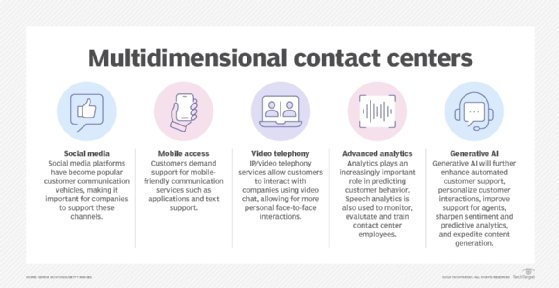
1966
AT&T introduced the first automated toll-free numbers using PBX technologies, enabling businesses to field a larger number of calls and boosting customer service contacts.
1973
Rockwell developed the automated call distributor to help businesses manage inbound calls, bringing the same kind of efficiency to voice calls that Sears pioneered for mail distribution.
IVR was first commercially used by Steven Schmidt for an order inventory control system. The technology enables callers to retrieve information from a contact center without talking to a human. Bank tellers also used IVR to verify customer balances.
1975
Signaling System No. 7 (SS7), a set of signaling protocols, was developed by AT&T to automate the process of setting up and tearing down phone connections outside of the calling channel. It helped mitigate issues in earlier signaling systems that allowed hackers to make free phone calls but lacks the security to protect against modern fraud techniques.
1980s
Outbound call centers used predictive dialing to place multiple calls at the same time to get a live person on the phone in the shortest amount of time, reducing idle time for call center agents.
1982
AT&T agreed to break up into Regional Bell Operating Companies, known as "Baby Bells," opening the door to competition and the introduction of more innovations in long-distance and call center technologies.
1989
Initially developed by Brian C. Wiles so PC gamers could talk to their opponents while playing video games against each other over their dialup modems, the remote audio sound card application link routed voice calls over the Ethernet, setting the stage for softphones in call centers with simpler LANs and Wi-Fi.
1991
John Walker, a founder of Autodesk, developed NetFone, the first VoIP service. Initially, VoIP builds a market with consumers hoping to work around high long-distance tariffs but evolves to improve call center efficiency.
1992
The first SMS message was sent when software architect Neil Papworth wished "Merry Christmas" to colleague Richard Jarvis. SMS ushered in the beginning of omnichannel contact center services.
1996
Mark Handley, Henning Schulzrinne, Eve Schooler and Jonathan Rosenberg created Session Initiation Protocol (SIP) to start, maintain and terminate communication sessions that include voice, video and messaging applications. Standardized in 1999 by the Internet Engineering Task Force, SIP provided a foundation for scaling VoIP services in the contact center.
1999
General Electric set up its first international call center in India to take advantage of lower labor costs, catalyzing the use of offshoring to drive down contact center expenses.
Salesforce's Marc Benioff, Parker Harris, Frank Dominguez and Dave Moellenhoff began work on the first cloud CRM system, inspiring several startups to create new approaches to hosting customer data in the cloud.
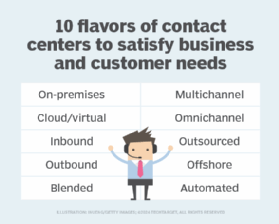
2001
Billing management company Amdocs acquired CRM software company Clarify to create a more consolidated contact center management platform for communications companies.
2002
Software company Utopy developed the first speech analytics software. First treated as a word-spotting technology, speech analytics is serving the contact center in multiple ways, including customer sentiment analysis and agent performance training.
2003
Struggling to compete with Walmart, Best Buy embraced a concept called customer centricity with an omnichannel infrastructure to help unify customer experiences online and in stores.
2007
Apple CEO Steve Jobs announced the company's first iPhone at the Macworld convention, ushering in an era of mobile customer interactions over multiple channels with the contact center.
2008
Twilio launched the first API, called Twilio Voice, to manage phone calls hosted in the cloud, paving the way for cloud-based contact centers.
Criminals organized contact centers masquerading as tech support to run scams, first starting with phone calls and later with text messages and malicious websites to trick consumers into downloading malware.
2010
Twilio followed up its release of an API to make and receive calls hosted in the cloud with the launch of a cloud-based text messaging API that helped scale a new contact channel for enterprises.
2013
Amdocs launched its cloud-based Unified Communications service, which integrates calling, SMS, social media and address book management into a common platform.
2014
Researchers discovered a technique for impersonating phone numbers to intercept consumers' identity verification codes when they interact with a contact center. Hackers later used this vulnerability in SS7 to drain bank accounts.
2016
Improvements in natural language processing, sentiment analysis and development tools drove the adoption of chatbots to automate responses to customer inquiries via websites, social media, SMS and phone calls.
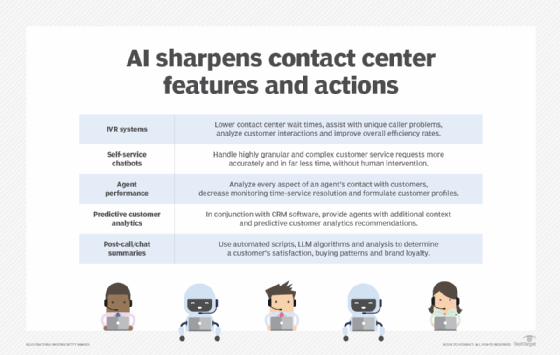
2020
The iSpoof.cc website was created, allowing criminal call centers to initiate calls and send text messages displaying a legitimate caller ID such as a bank. It was subsequently the subject of a global fraud investigation and shut down. The site took advantage of SS7 vulnerabilities that were never patched.
2021
Accent translation and noise cancellation startup Sanas launched an AI service that uses speech recognition and synthesis to adjust the accents of contact center agents for easier understanding on the customer's end.
2022
OpenAI launched ChatGPT, which provides the foundation for more capable customer self-service customer apps.
2024
The British Columbia Civil Resolution Tribunal found in favor of an Air Canada passenger, who claimed that an AI chatbot provided inaccurate information regarding the airline's discount policy on bereavement fares.
Scammers used deepfake technology to impersonate a company's CFO during a video call and defraud the company out of $25 million, raising concerns that criminal call centers using more sophisticated deepfakes will target consumers.
Beyond 2024
AI and GenAI will permeate practically every aspect of software functions as the contact center is seen more as a profit center that can meet customer demands for fast, seamless and personalized interactions on the channel of their choice. Potential improvements are seen in conversational analytics, mobility, agent retention and chatbot technology.
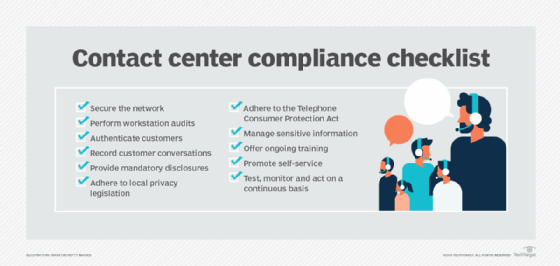
Laws for contact centers
Contact center automation has contributed to increases in aggressive, unethical and possible criminal practices, resulting in consumer complaints and government legislation. Several laws over the past few decades target outbound practices but also relate to the process of handling inbound inquiries at contact centers.
- Fair Debt Collection Practices Act was enacted in 1977. The law limits aggressive debt collection practices by specifying hours to contact consumers, precluding calls to the office, limiting repeated calls and allowing consumers to opt out of future contact.
- Telephone Consumer Protection Act (TCPA) was signed into law in 1991 and restricts automated unsolicited calls, text messages and faxes.
- Telemarketing Sales Rule enacted by the U.S. Federal Trade Commission in 1995 dictates that telemarketing organizations must require their agents to inform consumers of specific information, not misrepresent products, and allow consumers to opt out of future calls.
- Do-Not-Call Implementation Act was passed in 2003, allowing consumers to place themselves on a national registry to block unwanted telemarketing calls.
- Controlling the Assault of Non-Solicited Pornography and Marketing Act of 2003 promised to end spam email by putting it back in the "can," which helps explain its odd acronym CAN-SPAM. The law requires labeling emails as adult content and allows consumers to unsubscribe.
- Federal Communications Commission's 2013 revision of the Telephone Consumer Protection Act requires companies to get written consent of consumers before contacting them with pre-recorded calls.
- U.S. and Canadian regulators worked with telephone companies and the Internet Engineering Task Force to develop Secure Telephone Identity Revisited and Signature-based Handling of Asserted information using toKENs (STIR/SHAKEN) standards and guidelines in 2018 to improve caller ID security.
- EU's General Data Protection Regulation enacted in 2018 placed new requirements on contact centers to obtain consent, make recordings available to consumers and provide adequate agent training.
- Telephone Robocall Abuse Criminal Enforcement and Deterrence Act was passed in 2020 and mandated the adoption of STIR/SHAKEN.
- FCC ruled in 2024 that AI-generated voices in robocalls are now illegal because they're considered artificial, in a modern interpretation of the TCPA. The agency also put forth a proposal, which it calls the "first-of-their-kind robocall and robotext rules," that requires callers "to disclose their use of AI-generated calls and text messages" when interacting with consumers.
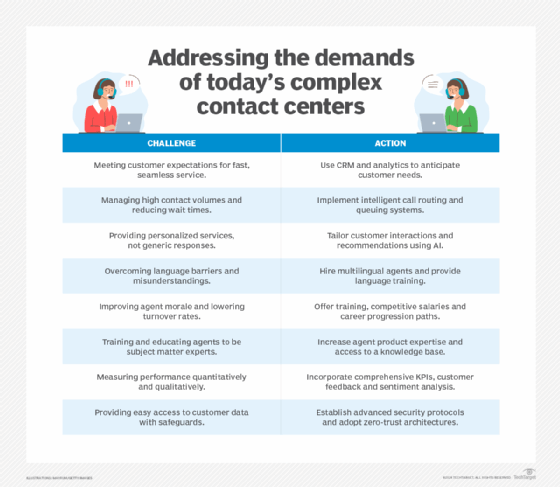
Future of contact centers
Vendors and enterprises will continue to evolve the contact center by improving automation, integrating siloed data across multiple channels and streamlining processes. Criminal organizations in the guise of contact/call centers will craft more effective scams and attacks using deepfakes, automated calling and more realistic voice chatbots.
Chatbot technology improvements, particularly using GenAI, will help enterprises improve customer interactions automatically. GenAI also will make the process of integrating unstructured data into more personalized and omnichannel customer experiences easier. But care will be required to mitigate the risks of AI hallucinations that create misleading information.
Contact centers will also increasingly adopt automated recording and analysis tools in agent training that improves customer interactions. The means to achieving better customer experiences will need to be balanced against data privacy protections, particularly in regions like the EU.
George Lawton is a journalist based in London. Over the last 30 years, he has written more than 3,000 stories about computers, communications, knowledge management, business, health and other areas that interest him.








